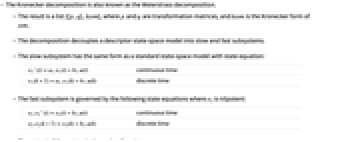KroneckerModelDecomposition[ssm]
yields the Kronecker decomposition of a descriptor state-space model ssm.


KroneckerModelDecomposition
KroneckerModelDecomposition[ssm]
yields the Kronecker decomposition of a descriptor state-space model ssm.
Details and Options

- The Kronecker decomposition is also known as the Weierstrass decomposition.
- The result is a list {{p,q},kssm}, where p and q are transformation matrices, and kssm is the Kronecker form of ssm.
- The decomposition decouples a descriptor state-space model into slow and fast subsystems.
- The slow subsystem has the same form as a standard state-space model with state equation:
-

continuous time 
discrete time - The fast subsystem is governed by the following state equations where e2 is nilpotent:
-

continuous time 
discrete time - The output of the system in Kronecker form is:
-

continuous time 
discrete time - The matrices a1 and e2 are both taken to be in Jordan form.
- StateSpaceTransform[ssm,{p,q}] has the form StateSpaceModel[{
 ,
, ,
, ,
, ,
, }], with
}], with  and
and  , where
, where  and a2 are identity matrices with the dimensions of the slow and fast subsystems, and
and a2 are identity matrices with the dimensions of the slow and fast subsystems, and  is a nilpotent matrix.
is a nilpotent matrix.
Examples
open all close allScope (4)
Applications (2)
KroneckerModelDecomposition decouples the fast and slow subsystems:
The number of 1s on the diagonal of the descriptor matrix gives the number of slow states:
Separate the slow and fast systems using SystemsModelExtract and SystemsModelDelete:
Properties & Relations (6)
The Kronecker decomposition and the original system are restricted equivalent systems:
They have the same controllability and observability properties:
They have the same transfer functions:
Nonsingular systems give an identity matrix for the descriptor matrix:
Find the Kronecker decomposition of a singular descriptor state-space model:
The matrix pair {p,q} relates the original system to the Kronecker form:
The inverse matrices perform the opposite transformation:
The slow and fast subsystems model the proper and improper parts of a transfer function:
The state matrix in the slow subsystem is in Jordan form:
The descriptor matrix in the fast subsystem is in Jordan form with all zero eigenvalues:
Related Guides
History
Text
Wolfram Research (2012), KroneckerModelDecomposition, Wolfram Language function, https://reference.wolfram.com/language/ref/KroneckerModelDecomposition.html.
CMS
Wolfram Language. 2012. "KroneckerModelDecomposition." Wolfram Language & System Documentation Center. Wolfram Research. https://reference.wolfram.com/language/ref/KroneckerModelDecomposition.html.
APA
Wolfram Language. (2012). KroneckerModelDecomposition. Wolfram Language & System Documentation Center. Retrieved from https://reference.wolfram.com/language/ref/KroneckerModelDecomposition.html
BibTeX
@misc{reference.wolfram_2025_kroneckermodeldecomposition, author="Wolfram Research", title="{KroneckerModelDecomposition}", year="2012", howpublished="\url{https://reference.wolfram.com/language/ref/KroneckerModelDecomposition.html}", note=[Accessed: 15-December-2025]}
BibLaTeX
@online{reference.wolfram_2025_kroneckermodeldecomposition, organization={Wolfram Research}, title={KroneckerModelDecomposition}, year={2012}, url={https://reference.wolfram.com/language/ref/KroneckerModelDecomposition.html}, note=[Accessed: 15-December-2025]}